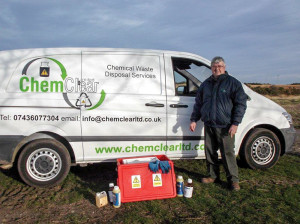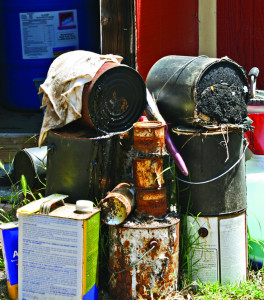Don’t get caught out!

The law dictates that all products deemed hazardous are stored correctly and are disposed of in the correct manor. Any person or organisation that does not store or dispose of hazardous waste and chemical waste correctly is liable for a large fine.
Firstly you need to identify what your waste is. Is it hazardous or non-hazardous? If you are unsure as to whether it is hazardous, look for the orange and black danger symbols or red and white hazard pictograms. There may be a product safety data sheet with the substance, this is produced by the manufacturer of the substances and will give an indication to any properties within that make it hazardous. Try to make your waste easily identifiable.
Apply labels to the containers showing (Your registered waste collector will help you with this):-
- That it is a waste product
- What it is. If it contains chemical then use the chemical identity rather than any nick names given to it
- Any hazards that maybe associated with it
- Emergency contact details

To put it into perspective, if you are holding 200 litres of used oil and also have 200 litres of new oil then you are already very close to the legal limit!! It's amazing how quickly these things add up!
Once registered, you will be given a six digit producer registration number. This number will be needed to complete the consignment note for disposal of your waste. You will also need to find the classification codes for each product to be disposed of. This is known as the EWC code and goes alongside a description of the products. Researching this isn't as daunting as it sounds. There is plenty of guidance available to help you do this on the internet or by contacting the Environment agency.
When storing your hazardous waste, you must ensure that it is done correctly. It must be placed in a split proof container that can be sealed. It should then be placed somewhere where it is protected from the elements such as the weather, rodents, slips, trips and falls. Certain products such as oil have specific storage requirements.
The storage of waste oils other than mineral-based oils are covered by the Control of Pollution (oil storage) (England) regulations 2001. These regulations were also introduced into Scotland in 2004, Wales & Ireland are also due to follow. The Environmental Protection Act 1990 and the PPC Regulations are regulations that have been formed to protect controlled waterways such as watercourses, canals and lakes etc. from pollution. They also help to protect the environment and prevent harm to our health.
Oil is the most common type of water pollution and forms 16% of reported cases. This is generally due to careless disposal into water causes, landfills and down drains. The environment agency states that 10 litres of oil disposed of incorrectly can spread, covering a surface of one hectare lake.
There are various chemicals that care needs to be taken with when being stored and disposed of. This is because some chemicals are made up of different properties and it is these properties that can react together if not stored correctly. There are specific guidelines for the storage of these types of chemicals that has been set out by the Health and Safety Executive. Information is available if you are unsure as to the properties within your chemicals and this is provided on a specific Material Safety Data Sheet (MSDS), there is more information on these on the internet.
The MSDS is intended to provide important information on how to handle and work with hazardous substances. It also provides information relevant to each substance such as physical data on the substance, toxicity, health effects, first aid requirements, storage info, disposal information, spill handling procedure etc.

Other data found on the MSDS gives information about associated hazards with specific chemicals. You should make yourself aware of the related hazards associated with the chemicals that are stored within your place of work and make sure that they are stored in the most appropriate storage area. When making the decision where to store them, there are various points that you should consider.
Firstly, what are the flammability characteristics of the substance? If it is known to be flammable, then it should be stored in a flame proof cabinet.
Will the chemical react with water? Is it an oxidiser? Will the chemical fuel a fire? If the answer to these questions is yes, then you should ensure that it is stored in isolation away from any water source in sealed containers. How corrosive is the substance? If it is corrosive, then this should be considered when choosing a storage system for it. Check to see how toxic the chemical is. If it is toxic, then its storage area should be located where it will not get knocked over in the event of an accident.
In some situations, a chemical may have a few of the above characteristics; if this is the case, then it should be stored to cover all eventualities.
Storage rules:
- Keep a record of the date that the chemical was obtained, as it is also worth remembering that generally, chemicals over three years old become 'out of code' and become illegal to possess
- Hazardous waste can only be stored at the place where it is produced, temporarily, for no longer than twelve months. Permanent storage requires a permit as it is classed as landfill Remember that the longer you store hazardous waste the more risk there is of corrosion, spillages etc.
- Keep an up to date list of what chemicals are on site
- Create a specific storage area for chemical with the appropriate safety equipment located nearby. This should be located in a quiet area without a lot of foot or vehicular traffic. It should be a cool and dry store with emergency telephone numbers easily visible
- Ensure that the storage area is within the work area
- Ensure that the storage is identified with appropriate hazard markings
- Ensure that each product stored is identified
- Ensure flammable substances are stored appropriately and in a quantity that does not exceed 60 gallons in the store. Only 10 gallons can be stored outside a store or in an approved refrigerator unit
- Do not store chemicals above eye level
- Chemicals stored on the floor should be in two containers
- Ensure than shelving is appropriate so that items cannot fall off
- All storage containers used should have well-fitting lids
- Avoid storing chemicals in alphabetical order, store like chemicals together
Ensure that all containers are packaged correctly and that it is being disposed of correctly at a registered site. The disposal site must hold an environmental permit or exemption permit.
Once the waste is collected from your organisation, paperwork relating to that specific waste will be sent with it. This is known as a consignment note. It is imperative that this paperwork is accurate and it remains with the waste at all times. It acts like a chain of evidence as to when the waste was collected and where it has been since.
The consignment note has 5 parts:-
- Part A - The Producer details
- Part B - The Waste details
- Part C - The Carrier details
- Part D - The Producer declaration
- Part E - The Details of waste acceptance
If the registered carrier completes the consignment note on your behalf, you have a responsibility to check that it is correct. The consignment note has three copies. One is kept by the organisation producing the waste, one is kept by the registered carrier and one is kept by the site that receives the waste for disposal. This paperwork must be kept for three years once the waste has been removed.
In 2012, the Health and safety Executive were stripped of any Government funding which means that they are now having to self-finance. In October 2012, they launched a new 'Fee for Intervention scheme.' This gives them authority to visit sites at random and, if they find anything wrong, no matter how small, they charge for their time at £124 per hour. On top of this charge, they give the customer between 21-28 days to correct the problem. One thing that they are keen to look at is the Chemical Store. So, as you can see, holding revoked chemicals and having a visit could amount to a large bill! By getting a registered firm in to deal with any unwanted/revoked chemicals could mean there is nothing to worry about when the HSE come to visit.
It is essential that you know what your responsibilities are when dealing with hazardous waste.
Article written by Chem Clear
